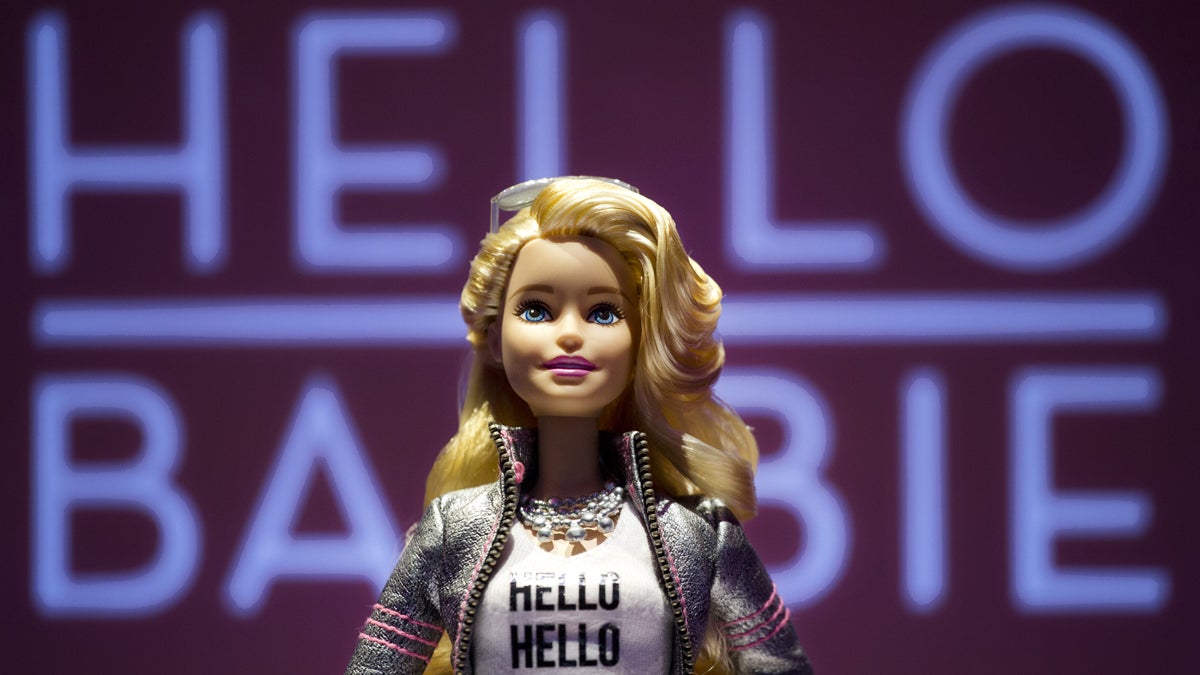Hello Barbie ‘smart doll’ still more fake than a kid’s imagination

File photo: Hello Barbie is displayed at the Mattel showroom at the North American International Toy Fair, Saturday, Feb. 14, 2015 in New York. (AP Photo/Mark Lennihan)
The Halloween cards are out, which means Christmas lights are twitching on the horizon, which means a toy store near you will soon be jammed with games and gadgets beseeching, “Take me home!”
I mean that literally. One of those just-in-time-for-December toys is Hello Barbie, a collaboration between Mattel and ToyTalk, an artificial-intelligence startup in San Francisco.
Unlike earlier iterations of “talking” toys that babbled a Möbius loop of responses in mechanized voices, Hello Barbie can “converse” using 8,000 lines of dialogue composed by a team of writers and recorded by a 23-year-old voice actress.
Every word a child says to Hello Barbie, swallowed by an embedded microphone that’s hidden in her necklace and activated by a button on her belt, is whisked via WiFi to ToyTalk’s servers. There, it’s instantaneously analyzed to prompt the proper response. Hello Barbie can initiate questions, play verbal games and remember to ask how that soccer game turned out last Wednesday.
No matter the topic, Barbie is programmed to respond reassuringly, something like the love child of Dr. Phil and Mother Teresa—benevolent, perceptive and morally irreproachable. Faced with an existential query — say, “Do you believe in God?” — Barbie might reply, “I think a person’s beliefs are very personal to them.”
“We are trying to build her personality from scratch into the perfect friend,” one of the writers of Hello Barbie’s dialogue told The New York Times. “I have no doubt [a girl] will ask Barbie all manner of those intimate questions that she wouldn’t ask an adult.”
I’m not sure what creeps me out more: the thought of a 6-year-old sharing her secrets and fears with a “friend” who has cleavage, or the idea that parents can later access and eavesdrop on those conversations. What is this Barbie, anyway? A plaything? Siri, with a face and feet? Or a svelte, well-dressed nanny-cam for anxious parents who’d give anything to know what their daughter is whispering to her teddy bears (or texting to her actual BFF).
It’s not hard to imagine a conversation with Barbie swerving hilariously (or alarmingly) off the rails: Barbie, where’s your mom? Barbie, how come you don’t have a belly button? Barbie…did you and Ken ever do it?
Loquaciousness, it turns out, isn’t the only new feature of Hello Barbie. Compared with previous models, her thighs are a bit thicker — alas, not to better approximate the proportions of the average American woman, but to accommodate tiny, rechargeable batteries. She wears less make-up than earlier generations of the doll, and her feet are flat, meaning she can’t share shoes with the Barbies you already have.
What’s more, Hello Barbie comes in three different “ethnicities” — vanilla skin with blond hair, café au lait skin with light brown tresses and a milk-chocolate skin tone with the same glossy, abundant hair, this time in dark brown.
Barbie, do black lives matter? Barbie, how come you straightened your hair? Barbie, what do you think of Donald Trump’s views on immigration?
Let’s not kid ourselves. Barbie’s been having a rough stretch, with sales of the brand falling from $1.3 billion in 2011 to a mere $1 billion last year. Meantime, toddlers clamor for iPads. No wonder the Powers That Be at Mattel wanted to pair up with the digital wizards of ToyTalk to capture a generation of young, female consumers with the first actual “smartdoll.”
Except that kids are even smarter.
When my partner was a little girl, she had an imaginary friend named Zsa Zsa Canyou, who was blue-eyed and bossy and sometimes came over to play house. One day when my partner was three years old, she climbed on a kitchen stool and picked up the phone. “Yes. Uh-huh. Oh.” She clambered down. “Zsa Zsa Canyou is in the hospital,” she reported solemnly to her mother and brothers, who must have wrestled mightily to keep their faces straight. “She got a broken foot in her tushie.”
Hello Barbie retails for $74.99. But there’s no price — and, thank goodness, no limit — on the loony, macabre, exuberant power of a child’s mind.
When our own daughter was a pre-schooler, any household object could become a figure in her richly anthropomorphized world. The shampoo bottle was married to the conditioner; the spoon squabbled with the fork. Bath time meant a new episode in the long-running dialogue between Bob, a squat, rubberized chap in a yellow slicker (the left-behind, put-upon baby brother), and Hibsie, a brittle plastic princess figure (the imperious, mischievous, occasionally tender big sister).
Night after night, Bob and Hibsie argued and made up, learned to dive into the soapy water (Bob was timid; Hibsie, brave) and confided their mutual fear of slipping down the drain. Their conversations were infinite and mutable, voiced by my daughter and scripted purely by imagination.
Are Mattel’s product-design people dumb enough to think kids will be satisfied for long with a doll who evades real questions and utters milquetoast platitudes? Or are they just that desperate to boost the brand’s sagging sales?
Here’s my prediction: Hello Barbie will have her 15 minutes of glory, like Pet Rocks and Tamagotchis before her. And then, her owners will grow rapidly bored of her bland manner and limited repertoire. Real friends (and imaginary ones, for that matter) are snarky and argumentative, sly and bossy, unpredictable and sweet. Real friends are not for sale.
Hey, Barbie, any last words before I stuff you in the back of the closet with the Silly Bandz and Rainbow Loom?
Yeah. I didn’t think so.
WHYY is your source for fact-based, in-depth journalism and information. As a nonprofit organization, we rely on financial support from readers like you. Please give today.

